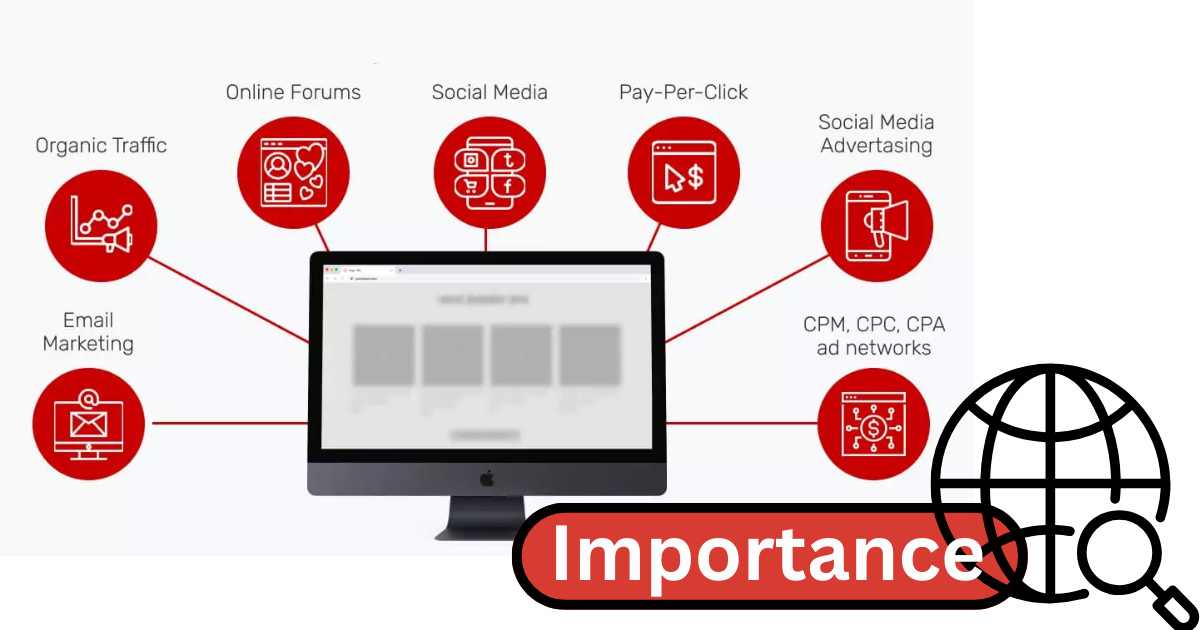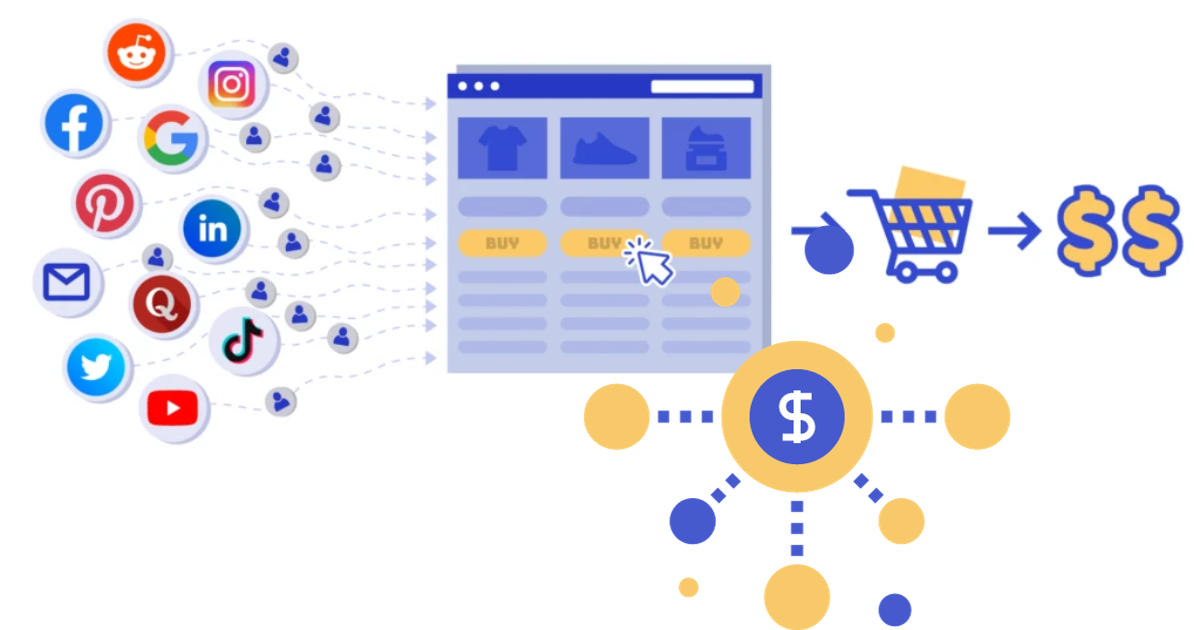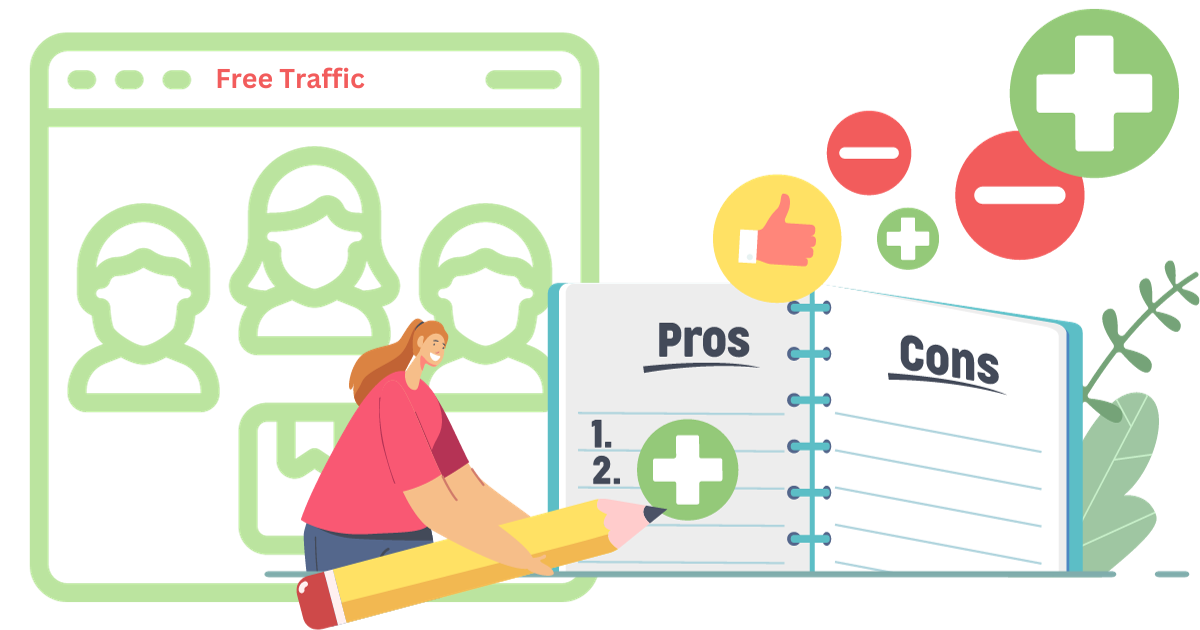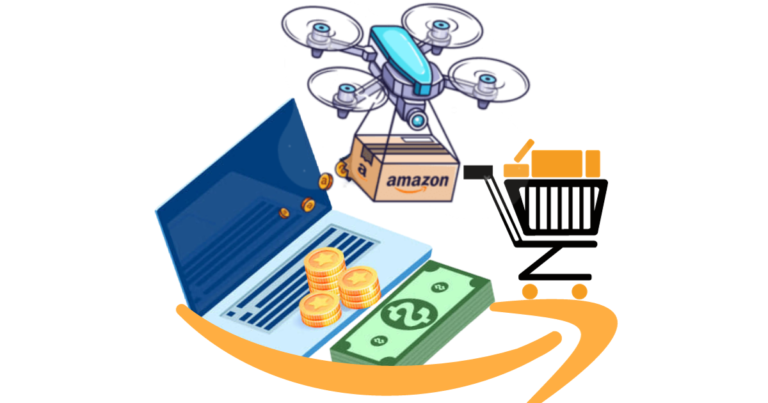Within the dynamic realm of digital marketing, affiliate marketing is a potent and easily obtainable means for people and companies to make money online via joint ventures. With the speed at which e-commerce and online businesses are expanding, it is now critical for anyone looking to take advantage of this profitable business model to grasp the principles of affiliate marketing.
Definition of affiliate marketing
Affiliate marketing is an internet marketing technique that is based on performance, whereby businesses or individuals (affiliates) promote and drive traffic to the products, services, or content of other businesses (merchants or advertisers) in exchange for compensation. According to this approach, affiliates receive compensation via special affiliate links or tracking tags for each sale, lead, or action brought about by their marketing efforts.
In this mutually beneficial relationship, merchants gain from a wider customer base and more sales without having to pay for advertising upfront, and affiliates serve as marketing middlemen by using their audience, online presence, and marketing expertise to promote goods and services. Affiliate marketing is a win-win situation that has grown in popularity as a successful and economical means for affiliates to monetize their digital assets and for businesses to increase their market presence.
The importance of traffic sources in affiliate marketing
It is impossible to overestimate the significance of traffic sources in affiliate marketing since they are essential to the success of any affiliate marketing plan. This is why traffic sources are so important:
Revenue Generation: For affiliate marketers, traffic sources are the main sources of income. There wouldn’t be any prospective clients to turn into leads or sales without a consistent stream of visitors. Diverse audiences with a range of requirements and interests can be drawn in by different traffic sources, increasing the likelihood of conversions.
Diversification: It can be dangerous to rely just on one source of traffic. Your affiliate marketing income may suffer if that source disappears or becomes less productive. Spreading the risk and ensuring a more steady revenue stream are achieved by diversifying your sources of visitors.
Targeted Audiences: To reach audiences that are specifically chosen, a variety of traffic sources can be employed. For instance, you can modify your advertising or content to fit the particular preferences and characteristics of your target audience. Because you are reaching people who are actually interested in the goods or services you are offering, this raises the possibility of conversions.
Scalability: You may grow your affiliate marketing business by using efficient traffic sources. You may allocate more time and resources to the sources that produce the greatest results as you hone your tactics and determine what works best, which will boost your income.
Data and Analytics: You may better understand your audience by utilizing the useful data and analytics that traffic sources offer. You may monitor which traffic sources result in the most conversions, which ones drive the most traffic, and even the demographic and geographic details of your site’s users. This information is crucial for strategy optimization.
Cost-effectiveness: Knowing how much each type of traffic will cost can help you manage your budget. Even though sponsored traffic sources demand a financial outlay, the ROI (return on investment) can frequently be calculated more precisely, letting you focus your budget where it will have the greatest impact.
Adaptability: Search engine algorithms, social media platforms, and customer behavior are all continually changing, making the affiliate marketing field dynamic. Maintaining a competitive edge in the market requires being aware of and flexible in the face of shifting traffic patterns and sources.
Long-term Sustainability: Increasing the diversity of your traffic sources can help your affiliate marketing firm remain viable over the long run. While some sources may yield results right away, others require time to develop yet result in more steady and long-lasting traffic.
Free Traffic Sources
Affiliate marketers see great value in free traffic sources since they can be used for cost-effective promotion and frequently provide high-quality, organic traffic. Effectively utilizing these resources can be a potent tactic for creating a long-lasting affiliate marketing company. Here are some important sources of free traffic:
Organic Search Traffic
The most reliable source of free traffic is organic search traffic. It originates from search engines such as Yahoo, Bing, and Google. Affiliate marketers have access to this resource by
- Optimization of Search Engines (SEO): Search engine optimization (SEO) is the process of making your website and content more search engine-friendly. Researching keywords, creating high-quality content, link building, and on-page SEO are all part of this long-term plan.
- Promotion of Content: Creating interesting, insightful, and valuable material on a regular basis helps draw in organic search visitors. Blog entries, articles, videos, and more can all be included in this content.
Marketing on Social Media
Social media networks offer plenty of opportunities for free traffic. Making the most of these platforms requires,
- Utilizing Social Media Channels: Determine the social media channels that your target market uses frequently. These might include LinkedIn, Pinterest, Instagram, Twitter, Facebook, and so on. It’s essential to interact with your audience on these sites.
- Creating a Powerful Online Presence: Post content frequently, interact with your fans, and establish yourself as a knowledgeable authority in your field.
Email Promotion
A tried-and-true strategy for generating free visitors is email marketing. In order to maximize it, you must,
- Build an Email List: The cornerstone of effective email marketing is the creation and upkeep of an email list. Gather email addresses using lead magnets, opt-in forms, and other techniques.
- Creating Email Campaigns That Get Results: Creating effective email campaigns can increase traffic to your affiliate offerings and increase conversion rates. These campaigns might include newsletters, product promotions, and instructional content. Effective personalization and segmentation are essential for success.
Guest blogging and content sharing
You can receive free, targeted traffic by guest posting on well-known platforms and sharing your material on pertinent websites. Here’s how to make the most of this tactic,
- Distributing Content: Distribute your information on websites, groups, or forums that are relevant to your sector and where your target audience is present.
- Guest Posting: Write guest posts in cooperation with respectable websites within your niche. These articles should link back to your affiliate offerings and benefit the readers of the host website.
Affiliate marketers can draw a consistent flow of organic, highly focused traffic to their affiliate offers by strategically leveraging these free traffic sources. When properly handled, these resources can give your affiliate marketing company a solid base and assist you in reaching long-term success.
Paid Traffic Sources
By allocating money resources, affiliate marketers can reach a wider, more focused audience more quickly with paid traffic sources. They need a budget, but they can be a useful tactic to increase affiliate commissions. The following are the main elements of sources of paid traffic:`
Pay-Per-Click Advertising (PPC)
With PPC advertising, marketers are charged a fee each time a click is made on their advertisement. You can use this technique to show advertisements on websites, social media platforms, and search engines. The two most well-known PPC advertising networks are Bing Ads and Google AdWords. Important factors for PPC are as follows:
- Keyword Selection: Selecting the correct keywords is crucial to reaching the correct audience.
- Ad Creatives: Ad creatives are responsible for creating eye-catching ad text and images that motivate clicks and conversions.
- Budget Management: Budget management involves creating a daily or monthly spending plan and tracking the return on investment.
Social Media Advertising
Social media sites like Facebook, Instagram, Twitter, and LinkedIn provide strong possibilities for targeting ads. In order to optimize the effects of social media marketing:
- Audience Segmentation: Segmenting your audience according to their demographics, hobbies, and habits is a good way to focus your marketing.
- Ad creatives and language: Produce captivating images and compelling language for your advertisements that appeal to your target demographic.
- A/B testing: Try out various ad elements to see which ones work best.
Display Advertising
Banner ads are displayed on several websites as part of display advertising. Retargeting is a potent tactic in which users who have already visited your website see advertisements. For optimal results with display advertising:
- Ad placement: pick online directories and media outlets that correspond with your intended market.
- Banner Design: Create attention-grabbing, aesthetically pleasing banners.
- Retargeting Campaigns: Use retargeting to get back in touch with those who have expressed interest in your offers.
Marketing with Influencers
You may reach their already-existing, attentive audience by working together with influencers in your niche. Think about the following while collaborating with influencers:
- Selecting the Correct Influencer: Look for influencers whose followers are similar to the people in your target market.
- Campaign Strategy: Plan the kind of promotions and material that will appeal to the influencer’s audience as part of your campaign strategy.
- Measuring Success: To determine ROI and assess the efficacy of your influencer initiatives, set up key performance indicators (KPIs).
Paid traffic sources are a useful addition to an affiliate marketer’s toolkit because they can yield quick results and precision targeting. But to make sure your investment pays off, you need to carefully track ROI, refine your campaigns on a regular basis, and manage your budget. You can develop a comprehensive and successful affiliate marketing plan by balancing paid and free traffic sources.
Pros and Cons of Free Traffic Sources
The Pros of free traffic sources
Cost-effectiveness is one important benefit of free traffic sources. These strategies are available to those on a tight budget since affiliate marketers can use them without having to make a direct financial investment. Furthermore, sustainable traffic can be obtained from free traffic sources; SEO work and content optimization can continue to generate traffic for a long time without incurring continuous costs.
These resources frequently draw in organic and attentive audiences, bringing in higher-quality traffic from those who are actually interested in the content or niche being advertised. Conversion rates may rise as a result, as well as engagement. Building authority in the niche and improving credibility and trustworthiness may also be accomplished by regularly using free traffic sources.
Cons of Sources of Free Traffic
Although sources of free traffic have many advantages, they can have drawbacks. The time-consuming aspect of these techniques is one obvious disadvantage. Using SEO, content production, and social media interaction to establish and sustain a presence may be difficult and require constant commitment and perseverance.
Furthermore, there is no assurance that using free traffic sources will be successful because of outside variables that may affect their efficacy, such as modifications to search engines or social network algorithms. For affiliate marketers hoping to grow quickly, these sources’ limited scalability may be a barrier. Because so many other affiliates are fighting for the same audience in highly competitive categories, it can be difficult to stand out and draw traffic.
In summary, for individuals on a tight budget who are dedicated to long-term success, free traffic sources offer an affordable and sustainable way to do affiliate marketing. However, since their efficacy might change over time, they necessitate continual effort and flexibility. Affiliate marketers would be wise to use a well-rounded approach that blends paid and free traffic sources in order to optimize their affiliate marketing success.
Pros and Cons of Paid Traffic Sources
The Pros of Paid Traffic Sources
The potential of sponsored traffic sources to produce quick, highly targeted results is one of their main advantages. Affiliate marketers can quickly reach a wide and targeted audience by using sponsored techniques like pay-per-click (PPC) and social media advertising. Increased affiliate commissions and speedy returns on investment may result from this.
Scalability is a feature of paid sources that lets marketers focus more resources on campaigns that work, making it easier to grow their affiliate marketing initiatives. Moreover, the capacity to measure ROI with greater accuracy facilitates efficient budget management, guaranteeing that expenditures correspond with revenue earned. In order to increase their online visibility and outreach, affiliates can greatly benefit from paid traffic sources.
Cons of Sources of Paid Traffic
Paid traffic sources have various drawbacks, despite their benefits. The main disadvantage is the required cash outlay. For those with little money, affiliate marketers may find it difficult to budget for their advertising initiatives. Furthermore, continued investment is frequently necessary for paid traffic to be sustainable; otherwise, traffic may decline. In addition, especially in well-liked sectors, advertisers have to deal with rivalry and bidding wars, which can raise advertising expenses. Furthermore, careful campaign management and optimization are needed from paid traffic sources to maintain control over expenses and lucrative conversions. In paid advertising, poor decision-making can result in resource waste.
To sum up, affiliate marketers looking to broaden their audience and boost their commissions might find great value in paid traffic sources due to their capacity for swift expansion and accurate targeting. They do, however, come with the difficulty of managing a budget and the requirement for ongoing optimization. A strong plan for affiliate marketing success can be achieved by using a balanced approach that incorporates both paid and free traffic sources.
Case Studies
Case Study No. 1: Successful Free Traffic
Sarah, an affiliate marketer specializing in health and wellness, depends on free traffic generated by social media and content. Her audience has come to trust her due to her consistent delivery of high-quality material and solid internet presence. With careful planning and execution, Sarah has been able to generate steady revenue from her website over time through organic growth.
Second Case Study: Paid Traffic Intensification
PPC advertising is one of the paid traffic sources that John, a tech affiliate marketer, uses. His highly tuned Facebook and Google AdWords campaigns have quickly raised his commissions and broadened his audience. John has been profitable by taking advantage of developments in the tech business, thanks to his ability to measure ROI correctly.
With their succinct case studies, affiliate marketing methods demonstrate the effectiveness of both paid and free traffic sources. These actual cases of success might serve as a source of inspiration for affiliate marketers as they develop their own strategies.
Conclusion
In conclusion, the decision to use paid or free traffic sources for affiliate marketing is crucial and based on personal objectives and financial capabilities. Free traffic sources are an affordable, long-term growth strategy, but they take time. Paid sources demand a financial investment but offer quick results and scalability. Achieving equilibrium between the two helps optimize the success of affiliate marketing. In this ever-changing field, monitoring, audience value, and constant modification are still essential.
[FAQ]
How can I determine which traffic source is best for my affiliate marketing niche?
The best traffic source for your niche depends on your target audience, competition, and budget. Conduct market research and test various traffic sources to see which one yields the best results. It’s often a trial-and-error process.
Which is better, free or paid traffic for affiliate marketing?
The choice between free and paid traffic depends on your goals, budget, and expertise. Free traffic methods take time to build but can be cost-effective in the long run. Paid traffic can provide quicker results but requires a budget and expertise in ad management. Many affiliate marketers use a combination of both.
Can I use both free and paid traffic sources in my affiliate marketing strategy?
Yes, many successful affiliate marketers use a combination of free and paid traffic sources. This diversifies their traffic and can lead to better overall results. However, it’s crucial to have a well-planned strategy for both types of traffic.













